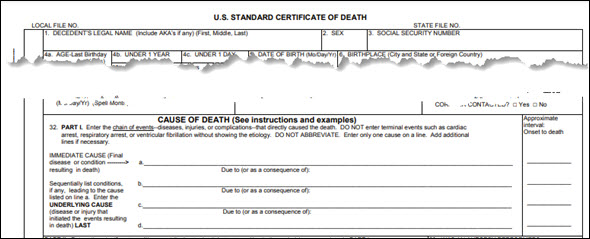Immediate, ultimate, proximate
Reader Trudie Davis-Long was puzzled by some of the terminology found in death certificates she’s seen. In some cases, the word used to described the cause of death was “ultimate.” In others, “proximate” (on some forms, “proximal”). Modern death certificates add in “underlying.” And then, of course, there’s “immediate.”
What’s the difference?
Legally — a big one.

In all cases, the words “ultimate,” “proximate/proximal” and “underlying” are interchangeable and mean the same thing: “the disease or injury that initiated the chain of events that led directly and inevitably to death.”1
In all cases, the word “immediate” means “the final disease, injury, or complication directly causing death.”2
And, in all cases, the report of a death works in reverse chronological order:
The first condition listed is the immediate cause of death, i.e. the condition which caused the individual to die at that time and in that place. The last condition listed is the proximate (or underlying) cause of death, i.e. the condition which started a chain of events leading to death. In some cases, these are one and the same—for example, “Toxic effects of cocaine”. More commonly, the chain has multiple links. For instance, if an individual suffered brain injury from a fall and, while bedridden and unconscious, developed pneumonia which led to death, his or her cause of death could be listed as, “Pneumonia, due to blunt force head trauma, due to fall.”3
Another example: “a man sustains a transabdominal gunshot wound with perforation of the colon. In spite of multiple operations and other treatment, over a period of three months, he develops generalized peritonitis, septicemia, disseminated intravascular coagulation and adult respiratory distress syndrome. The abdominal gunshot wound is the proximate or underlying cause of death and all of the complications listed are the immediate causes of death.”4
From “immediate” back all the way to “ultimate,” “proximate/proximal” or “underlying,” the chain of events has to be unbroken. If the person who fell had recovered fully and then died from pneumonia sometime later, the chain is broken and the fall isn’t the underlying cause of death. If the person who was shot had recovered fully from the gunshot wound, and then died because of other unrelated issues down the road, the gunshot wouldn’t be the underlying cause of death.
And that’s a big deal legally. Because you can’t charge somebody with murder if the underlying cause of death isn’t the act of the person you want to charge. Criminal homicide — the category that includes murder — is only “when one human being causes the death of another.”5
The things you learn reading death certificates…
Cite/link to this post: Judy G. Russell, “A deadly proximate cause,” The Legal Genealogist (https://www.legalgenealogist.com/blog : posted 5 Dec 2022).
SOURCES
- U.S. Standard Certificate of Death, Centers for Disease Control, November 2003; PDF, CDC.gov (https://www.cdc.gov/ : accessed 5 Dec 2022). ↩
- Ibid. ↩
- “Cause and Manner of Death,” Clark County, Ohio; PDF, Clarkcountyohio.gov (https://www.clarkcountyohio.gov/ : accessed 5 Dec 2022). ↩
- “Glossary,” Harris County (TX) Institute of Forensic Sciences (https://ifs.harriscountytx.gov/ : accessed 5 Dec 2022). ↩
- See generally Wex, Legal Information Institute, Cornell Law School (https://www.law.cornell.edu/wex : accessed 5 Dec 2022), “homicide.” ↩
* This article was originally published here

Social Plugin